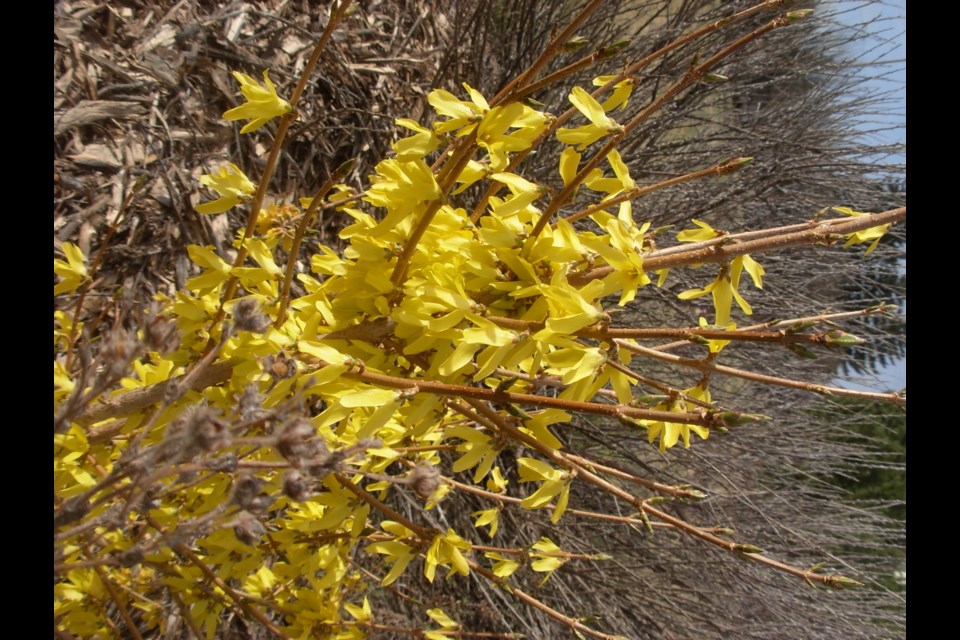Each spring, in a subtle ritual that I probably share with most people who love plants, I look for signs and make my rounds to reaffirm that the trees and shrubs around me are still alive and well. A sure early sign is the swelling of leaf and flower buds. In the city, elms that line the streets will be looking fuller and rusty brown as their flower buds get ready to open. Here and there a forsythia will make itself known with a flush of yellow blossoms. A look around Patterson Arboretum is sure to pay off with tiny budding flowers on currants (Ribes), the silver maple (Acer saccharinum), and unfolding little green leaves on cherry prinsepia (Prinsepia sinensis). As the snow disappears, I will pay a visit to my farm tree collection to see unusual early flowers like those on leatherwood (Dirca palustris) and sweetfern (Comptonia peregrina) shrubs. Predictably, everything will be as it should be and ready for another growing season.
Last December, thanks to a lack of snow cover and unseasonably warm weather, I was out pruning hedges at the Horticulture Field Lab where I work. As some of the high branches of European violet willow (Salix daphnoides) fell to the ground, I noticed that they already had developed white catkins ( the flower clusters of willows and some other types of trees). Was this a case of being fooled by the weather, or was it getting a very early start on spring flowering? Either way, it is a testament to the hardiness and determination of this species, which will certainly be covered in fuzzy white catkins by April. Violet willow trees are not commonly planted, although there are a few on the University of Saskatchewan campus which I seek out as part of my spring rounds. Their flower clusters are large and showy, although perhaps not as adorable as our native pussy willow.
Flowers of course have an innate mission: to be pollinated to produce seeds. Willow flowers can form as early as they like since they are wind-pollinated. The showy flowers that we are most familiar with, such as those on crabapple trees, are more restricted to the warmer side of spring when they can be pollinated by foraging insects.
Wind-pollinated trees, which can start the season early, include birch (Betula) and alder (Alnus). In the front of Patterson Arboretum in Saskatoon is a native speckled alder, Alnus incana, and every spring I check for its elongating, drooping pollen catkins. They are not colourful, but they are fairly showy and hang down lazily, covering the shrub and moving in unison with any breeze.
Forsythia is always one of the first colourful flowers, arriving while other plants are still leafless. The flowers are bright yellow, abundant, and appear before the leaves, and thus a blooming forsythia is a very showy plant on a background of brown. The flowers first open on the lower branches, where there is generally a bit more warmth radiating from the ground, but quickly the entire plant is covered in blossoms. Forsythia ovata ‘Northern Gold’ is commonly planted, although there are other cultivars and species that will thrive in the prairie region. They can be grown easily from seed and cuttings. Forsythia is related to lilacs (olive family, Oleaceae), and similarity can be seen in both their flower structures (four-lobed) and in their opposite leaf arrangement. Both forsythias and lilacs are native primarily to Asia.
My spring rounds invariably take me to my farm tree collection, where I can always depend on a particular Dahurian rhododendron (Rhododendron dauricum) to be generous with bright pink flowers. In Saskatchewan, some types of rhododendrons can thrive if given the conditions that they need: a site that mimics their natural forest home as closely as possible. Forests are generally places of semi-shade, humidity, and soil rich in organic matter. Among my farm trees, this rhododendron grows under larch trees, in a low spot where rain and snow-melt provide moisture. In the city, planting on the shady north side of a house, beyond the house’s rain shadow (close to the house will be too dry), will do the trick. A wood mulch to shade the roots and enrich the soil is also beneficial. At the University of Alberta Botanic Garden near Edmonton, there is a glade in a natural conifer forest which is planted with several rhododendron species and cultivars. On such a site, there is shade, forest soil, and shelter from the wind.
This year perhaps, get an early start on spring by looking for the subtle botanical signs that the season is changing. There is so much to see and many different flower types everywhere. Then before you know it, you’ll be awash in the familiar and more in-your-face spectacle of pink crabapple trees, lilacs, and white cherry bushes.
This column is provided courtesy of the Saskatchewan Perennial Society (SPS; [email protected] ). Check our website (www.saskperennial.ca) or Facebook page (www.facebook.com/saskperennial) for a list of upcoming gardening events



